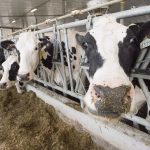
Now, they have over 2,000 cows on their dairy farm and cheese factory in Waterloo. Because managing the business means using a good deal of energy, sustainability has been an ongoing goal.
“Sustainability for us means repeatability,” George Crave said. “It means what we’re doing today we can do in the future, we can do in five or ten years from now. ”
One of the ways they’re doing that is by converting manure into electricity.
The anaerobic digester on their farm takes the methane from cow manure and produces enough electricity to power not only their farm and cheese factory but 300 local homes.
“Farmers are always looking at … how we can do things better for the future and maintain really profitable levels, yet still be responsible for our community and our employees and the Earth,” Crave said.
Dane County Executive Joe Parisi says digesters are a type of clean energy-producing technology important in sustainability efforts — and a way both farmers and communities are adapting to changing weather conditions brought about by climate change.
“Digesters are a solution that can help farmers remain viable, that can contribute to water quality and that can contribute to our efforts to reduce greenhouse gas emissions,” he said.
While the digester on the Crave farm primarily produces electricity, the county is working to adopt a new, more lucrative focus: natural gas production. The digester near Waunakee is currently under construction to make the switch.
Parisi says the natural gas produced by the Waunakee digester is expected to be sold as transportation fuel, which would offset the carbon emissions of around 4,000 cars each year.
“It’s not only a very good way to offset greenhouse gases, but it makes the economic model even stronger for the digesters,” he said.
Making digesters more financially viable is key to growing their popularity. The U.S. has already seen a huge rise in its number of digesters.
According to data from the Environmental Protection Agency, there were just 25 digesters in 2000. By 2019, there were more than 250 — an over 900 percent increase.
And in Wisconsin, the number has more than doubled within 10 years, going from 18 in 2009 to 39 in 2019.
Parisi says he hopes to see even more in the future. But for the Crave brothers, it’s about making a difference at home.
“Farmers are doing a good job,” Crave said. “We’re out here every day, working with the soil, working with our cattle and always trying to do the best job we can for our environment and the consumers.”
























